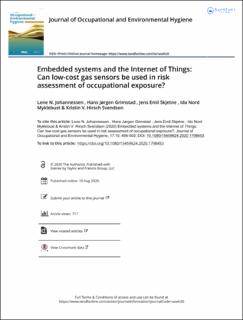| dc.contributor.author | Johannessen, Lene Nanette | |
| dc.contributor.author | Grimstad, Hans Jørgen | |
| dc.contributor.author | Skjetne, Jens Emil | |
| dc.contributor.author | Myklebust, Ida Nord | |
| dc.contributor.author | Svendsen, Kristin V Hirsch | |
| dc.date.accessioned | 2021-02-04T14:18:32Z | |
| dc.date.available | 2021-02-04T14:18:32Z | |
| dc.date.created | 2021-01-04T16:48:42Z | |
| dc.date.issued | 2020 | |
| dc.identifier.citation | Journal of Occupational and Environmental Hygiene. 2020, 17 (10), 495-503. | en_US |
| dc.identifier.issn | 1545-9624 | |
| dc.identifier.uri | https://hdl.handle.net/11250/2726248 | |
| dc.description.abstract | The Internet of Things (IoT) explores new perspectives and possible improvements in risk assessment practices and shows potential to measure long-term and real-time occupational exposure. This may be of value when monitoring gases with short-term maximum levels and for time-weighted average (TWA) concentrations used in standard measuring practices. A functional embedded system was designed using low-cost carbon monoxide (CO) electrochemical sensors and long-range-wide-area-network radio communication technology (LoRaWAN) was used to enable internet connectivity. This system was utilized to monitor gas levels continuously in the working atmosphere of an incineration plant over a 2-month period.
The results show that stable and long-term continuous data transfer was enabled by LoRaWAN, which proved useful for detecting rapid changes in gas levels. However, it was observed that raw data from the low-cost sensors did not meet the NIOSH accuracy criteria of ±
25% of the estimated true concentration based on field data from a co-located gas detector that met the NIOSH accuracy criteria. The new IoT technologies and CO sensor networks shows potential for remote monitoring of exposure in order to: (1) detect rapid changes in CO and other possible hazardous airborne gases; and (2) show the dynamic range of real-time data that may be hazardous for workers in the sampled areas. While the IoT low-cost sensors appear to be useful as a sentinel for monitoring hazardous atmospheres containing CO, the more useful finding may be showing real-time changes and the dynamic range of exposures, thus shedding light on the transient and toxic nature of airborne hazards. More importantly, the low-cost CO sensors are not a clear substitute for the more costly real-time gas detectors that perform within the NIOSH accuracy criteria. | en_US |
| dc.language.iso | eng | en_US |
| dc.publisher | Taylor and Francis | en_US |
| dc.rights | Attribution-NonCommercial-NoDerivatives 4.0 Internasjonal | * |
| dc.rights.uri | http://creativecommons.org/licenses/by-nc-nd/4.0/deed.no | * |
| dc.title | Embedded systems and the Internet of Things: Can low-cost gas sensors be used in risk assessment of occupational exposure? | en_US |
| dc.type | Peer reviewed | en_US |
| dc.type | Journal article | en_US |
| dc.description.version | publishedVersion | en_US |
| dc.source.pagenumber | 495-503 | en_US |
| dc.source.volume | 17 | en_US |
| dc.source.journal | Journal of Occupational and Environmental Hygiene | en_US |
| dc.source.issue | 10 | en_US |
| dc.identifier.doi | 10.1080/15459624.2020.1798453 | |
| dc.identifier.cristin | 1865123 | |
| dc.description.localcode | © 2020 The Author(s). Published with license by Taylor and Francis Group, LLC This is an Open Access article distributed under the terms of the Creative Commons Attribution-NonCommercial-NoDerivatives License (http://creativecommons.org/licenses/bync- nd/4.0/), which permits non-commercial re-use, distribution, and reproduction in any medium, provided the original work is properly cited, and is not altered, transformed, or built upon in any way. | en_US |
| cristin.ispublished | true | |
| cristin.fulltext | original | |
| cristin.qualitycode | 1 | |

